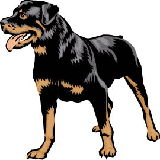Big DogsInformation About The Norwegian Elkhound Dog Breed |
|
|
History and origin : The Norwegian Elkhound has existed in Norway for centuries and was used as a herd guarder and a hunter of elk and other game. This breed traces his lineage back to the Viking days. He was bred to have strength, an excellent sense of smell, endurance, and stamina in the cold Norwegian winter. Description : The Norwegian Elkhound stands 19 to 21 inches at the shoulder and weighs between 45 to 60 pounds. He has a robust, well-muscled body and a medium-length, thick, insulating coat with a dense undercoat. Shedding is year-round, and the dog requires daily brushing. The color is silver-and-gray with black-tipped guard hairs dispersed throughout the coat. About the breed : The Norwegian Elkhound is a happy, active, and energetic breed. He exhibits intelligence, strength, and alertness. He is loyal and devoted to his owners and reliable with children. His sense of smell is strong and will serve to distract the dog. Independent, dominant, and stubborn, this breed can be a challenge to train. One must be firm and consistent to gain leadership over a Norwegian Elkhound. Initially suspicious of strangers, the Elkhound makes a good watchdog, but he must receive socialization from an early age in order to modify his tendency toward territorial aggression. He can be aggressive toward other dogs and small animals. Bred to bark upon locating prey, the Elkhound has retained this habit, which, combined with his energy and athleticism, makes him an unlikely apartment dog. This breed is not recommended for those who have small children. Training must begin early and must focus particularly on the "Come" command. Feeding : Recommended feeding for this breed is 1-1 ½ cans (13.3oz) of high-quality meaty product with biscuit added in same amount or 3 cupfuls of a complete, dry dog food. Ideal home : This breed needs a house with a fenced yard as well as daily exercise. Older children are okay, provided there are no teasing and roughhousing. The owner of a Norwegian Elkhound must be a strong leader, and must be able to establish and maintain the dominant position. Spoilers will create a dominant, pushy, potentially aggressive dog. Owners must allot time for daily training, grooming, and exercise. Weak leaders, cautious or nervous types, and those concerned about shedding should pass on this breed. Consider a female rather than a male because they often make better, more controllable house pets. The elderly and the disabled may have a difficult time controlling this high-strung breed. Back to the Big Dog Breed article page
| |
|
Related News About Dogs ' ); // get rid of newsfeed display by carp CarpConf('poweredby',''); CarpCacheShow('http://classifieds.agriscape.com/syndicate/dogs.rss'); ?>
|
|
|
|
|
|
Copyright © 2006-2007 dogguidance.com |


